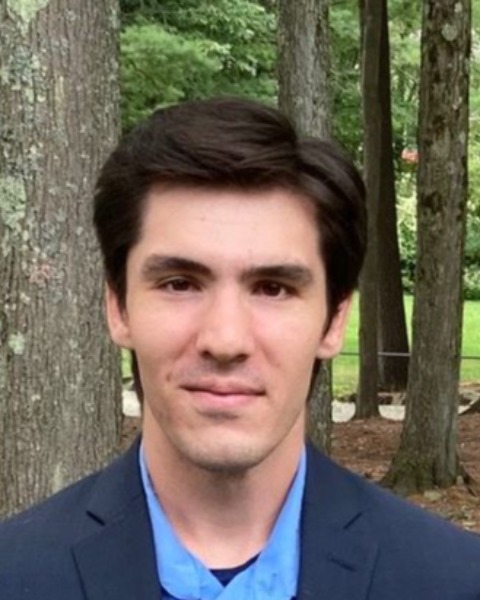Neural Engineering
Direct Current Stimulation Induced Neural Stem Cell Migration and Cytoskeletal Changes
(K-416) Direct Current Stimulation Induced Neural Stem Cell Migration and Cytoskeletal Changes

Alex Ropars (he/him/his)
Undergraduate Researcher
Binghamton University
Vestal, New York, United States- RT
Ruiping Tang
Graduate Researcher
University of Georgia, United States - LK
Lohitash Karumbaiah
Associate Professor, Edgar L. Rhodes Center for Animal and Dairy Science
University of Georgia
Athens, Georgia, United States
Presenting Author(s)
Co-Author(s)
Primary Investigator(s)
Traumatic brain injuries (TBI) impact the lives of millions worldwide. According to the Centers for Disease Control and Prevention (CDC), there were 223,135 TBI-related hospitalizations in 2019 and 69,473 deaths in 2021 [1]. Following the primary injury, the progression of secondary injury cascades in the weeks and months after causes significant brain damage. Inherently, the brain attempts to repair the damage through neurogenesis using neural stem cells (NSCs), which can replace damaged or lost neurons. However, neurogenesis is inefficient due to the lack of chemoattractants and the lengthy distance needed to travel to reach the lesion site [2]. Previous studies have demonstrated the capacity of electrical stimulation to manipulate cell behaviors both in vivo and in vitro [3], and direct current stimulation (DCS) has shown a lot of promise in enhancing NSC migration while maintaining stemness. In particular, cathodal DCS (cDCS) applied intermittently has been shown to reach higher field strengths and maintain cell viability compared to continuous DCS [2]. The aim of this study was to further characterize the use of intermittent cDCS on NSCs cultured in two dimensions (2D) by applying cDCS for 1 and 4 hours and to determine optimal parameters for future work.
Materials and Methods:
Human neural stem cells (hNSCs), derived from human induced pluripotent stem cells (hiPSCs), were cultured in 2D cultures on 100 mm Petri dishes coated with a Geltrex matrix. Once confluent, hNSCs were replated at 20,000 cells/cm2 in 35 mm glass bottom (14 mm in diameter) Petri dishes coated with Geltrex. Following overnight incubation, dishes were moved to the Tokai Hit live cell imaging chamber with the DCS set-up (Figure 1) on a Leica DM-IRBE inverted microscope with a Hamamatsu Orca Flash 4.0 camera. Sham and treatment groups (N=3 and N=4) were recorded for 1 hour (objective: 10x, resolution: 2048x2048, frame rate: 1 Hz). Samples were treated with electric fields of 300, 400, and 500 mV/mm, with 65, 92, and 115 mA of current, respectively, using a Keithley 2280 DC power supply. A variable resistor maintained these conditions, set to 52 ohms, while a multimeter monitored current flow within the circuit. A second experiment at 400 mV/mm used intermittent and continuous stimulation (N=2 and N=1) for 4 hours. Live-dead assays were performed on sham and treatment groups (N=3) after 4 h of intermittent stimulation. Videos were analyzed using the Manual Tracker and Chemotaxis plugins from ImageJ, quantifying directionality, average velocity, and Euclidean distance. Kruskal-Wallis test and Dunn’s post hoc comparisons were used for statistical analysis in GraphPad. Immunocytochemistry was performed, staining for Nestin (NSC marker) and actin filaments using Phalloidin Texas Red to assess the stemness of cytoskeletal changes of hNSCs, respectively.
Results, Conclusions, and Discussions:
In 1 h DCS, there was no difference in Euclidean distance, but treatment groups showed a significant increase in directedness (Kruskal-Wallis, p < .0001, with Dunn’s multiple comparsion, p300 = .0002, p400 < .0001, p500 = .0082) and significant decrease in average velocity directedness (Kruskal-Wallis, p < .0001, with Dunn’s multiple comparsion, p300 < .0001, p400 < .0001, p500 < .0001) when compared to sham groups (Figure 2). Multiple treatment groups had significant uniformity in directedness after performing Rayleigh tests on their data sets (p < .05). In 4 h DCS with a 400 mV/mm field applied, there was a significant increase in Euclidean distance, while directedness and average velocity showed significant differences from the 1 h groups (Figure 3). No significant difference existed between intermittent and continuous current average velocities or Euclidean distance at 4 hours. While there was significance in directionality, this is likely due to natural variation. Cells maintained their stemness, with high populations of Nestin+ cells (Figure 4). The cytoskeleton showed visible changes, with actin filament extensions towards the cathode. Live-dead assays showed a tendency for cell viability to decrease with extended cDCS application (Figure 5). Reducing the current while maintaining the same field strength could increase viability over longer durations. During experimentation, cell seeding presented persistent issues with cluster formations. NSCs by nature try to form clusters in 2D culture, and any size appears to impede migration with actin filament interlacing at cell-cell adhesion points (Figure 4).
In both time frames, NSCs showed significantly enhanced directionality and decreased average velocity compared to sham groups, while increasing the duration of stimulation significantly increased Euclidean distance. The decrease in average velocity can be attributed to a natural gradient that occurs during extended DCS applications. Though not statistically significant, cell viability showed a decreasing trend with extended DCS application, which could be improved with reduced current. Further investigation of how to limit the change in velocity, such as media replacements after certain time points, and improving cell viability, will be an important step before moving to 3D migration studies.
Acknowledgements (Optional) :
This research was supported by NIH R01 funding to LK 1R01NS099596-01A1. AR was supported by the National Science Foundation Research Experiences for Undergraduates (REU) site program under Grant No.1950581
References (Optional) :
[1] Get the facts about TBI. Centers for Disease Control and Prevention (2023). [2] Feng, J.-F. et al., Stem Cell Reports 9, 177–189 (2017). [3] Chen, C., Bai, X., Ding, Y. & Lee, I.-S., Biomaterials Research 23, (2019).
